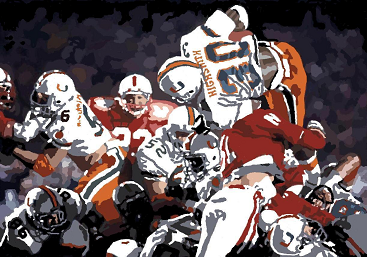2) Nebraska 12-1
3) Auburn 11-1
4) Georgia 10-1-1
5) Texas 11-1
6) Florida 9-2-1
7) Brigham Young 11-1
8) Michigan 9-3
9) Ohio State 9-3
10) Illinois 10-2
11) Clemson 9-1-1
12) Southern Methodist 10-2
13) Air Force 10-2
14) Iowa 9-3
15) Alabama 8-4
16) West Virginia 9-3
17) UCLA 7-4-1
18) Pittsburgh 8-3-1
19) Boston College 9-3
20) East Carolina 8-3
This poll was extremely difficult to fix, largely because of bitter, never-ending imaginary arguments between myself and AP voters. The most difficult issue was 7-4-1 UCLA, who beat 10-2 Illinois 45-9 in the Rose Bowl. There's no doubt in my mind that UCLA should be rated ahead of Illinois, and that Illinois should be rated ahead of 9-3 Michigan. Illinois won every Big 10 game and beat Michigan 16-6.
But on both those issues, the AP poll had just enough of a case to keep me going back and forth on the matter for a couple of weeks now. Some potential corrections sit right in the middle of a very gray area between necessary and not, and putting UCLA up ahead of Illinois is one of those.
But the most interesting controversy of 1983 is #1, where 11-1 Miami-Florida landed after a monumental upset of Nebraska in the Orange Bowl, jumping over 11-1 Auburn, who played a schedule that was far tougher. In fact, it was the toughest schedule in college football that year. In further fact, it was and still is one of the toughest schedules ever played in college football history (4th toughest ever by the NCAA's measurement of strength of schedule).

Miami has been involved in some of the biggest upsets in bowl history, usually on the wrong end, but their glory years began with a huge 31-30 upset of #1 Nebraska in the 1984 Orange Bowl, giving them their first national championship.
